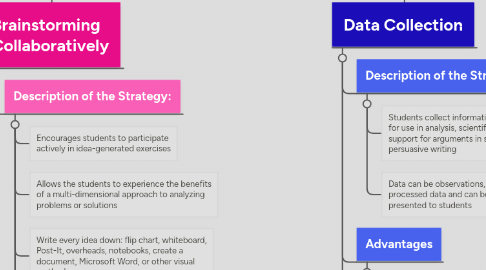
1. Brainstorming Collaboratively
1.1. Description of the Strategy:
1.1.1. Encourages students to participate actively in idea-generated exercises
1.1.2. Allows the students to experience the benefits of a multi-dimensional approach to analyzing problems or solutions
1.1.3. Write every idea down: flip chart, whiteboard, Post-It, overheads, notebooks, create a document, Microsoft Word, or other visual methods
1.1.4. Structured
1.1.4.1. The whole class is given a topic to discuss and each student is called upon to contribute an idea
1.1.4.1.1. Advantage: All students participate, and the more vocal students tend not to dominate the discussions
1.1.4.1.2. Challenges:
1.1.5. Unstructured
1.1.5.1. Students are encouraged to contribute ideas as and when they think of them
1.1.5.1.1. Advantage: Allows for a freer flow of ideas and a more relaxed environment
1.1.5.1.2. Challenge: Can lead to the students not responding at all, or to a few students dominating the discussion
1.1.6. Group
1.1.6.1. The class is broken into small groups, and each group presents its ideas after an allotted amount of time
1.1.6.1.1. Advantages:
1.1.6.1.2. Challenge: Requires more class time
1.2. Advantages to Brainstorming
1.2.1. This strategy is applicable to all teaching scenarios--labs, lectures, or discussion sections
1.2.2. There is no one correct answer--it allows for multiple answers
1.3. Incorporating Technology
1.3.1. Brainstorming Software
1.3.1.1. Kidspiration
1.3.1.1.1. Students use graphic organizers to express thoughts and explore ideas and relationships
1.3.1.1.2. They create graphic organizers including webs, concept maps and Venn diagrams to clarify thoughts, organize information, apply new knowledge, and build critical thinking skills
1.3.1.2. Google Docs
1.3.1.2.1. Students can collaborate and brainstorm together on a collaborative document
2. Data Collection
2.1. Description of the Strategy:
2.1.1. Students collect information in an organized way for use in analysis, scientific research, or as support for arguments in social studies or persuasive writing
2.1.2. Data can be observations, raw data, or processed data and can be collected by or presented to students
2.2. Advantages
2.2.1. Having students gather and analyze data can connect them to real-world problems
2.2.2. Can help improve students' critical thinking skills
2.3. Challenges
2.3.1. Making sure the students are not collecting data for the sake of collecting data, but making it meaningful
2.4. Incorporating Technology
2.4.1. Creating graphs on Microsoft Excel
2.4.2. Survey Monkey
2.4.2.1. Create and publish online surveys in minutes, and view results graphically and in real time
2.4.3. Kids'Zone: Creating a Graph
2.4.3.1. Four different graphs and charts for students to choose from to create graphs once they have collected data
